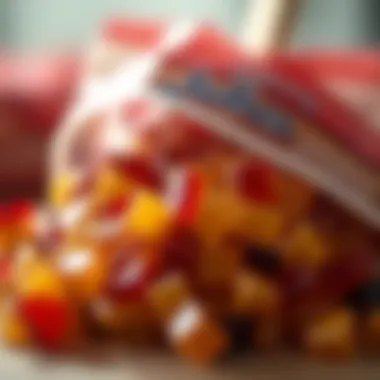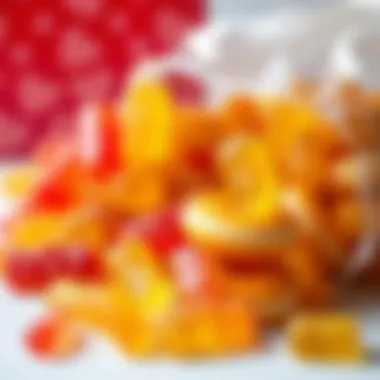Exploring the Diverse Nature of Jubes Candy


Intro
Jubes candy, a delightful confection adored by many, finds its roots entwined with cultural tradition and culinary innovation. These chewy and colorful sweets offer a tantalizing medley of flavors that can transport both young and old to a world of sugary bliss. For those passionate about culinary arts or simply those who enjoy a good treat, understanding the essence of these candies is essential. This article seeks to explore the foundational aspects of jubes, including their intriguing history, the processes involved in their crafting, regional adaptations, and even their health considerations. It aims not just to impart knowledge, but to nurture a deeper admiration for this unique candy, revealing the layers beneath its sugary surface as it carves its niche in the global confectionery landscape.
Recipe Overview
Recipe Name
Classic Jubes Candy
Cuisine Type
Confectionery
Ingredients
List of Ingredients with Measurements
- 1 cup granulated sugar
- 1/2 cup light corn syrup
- 1/2 cup water
- 2 tablespoons unflavored gelatin
- 2 teaspoons flavor extract (such as vanilla, raspberry, or lemon)
- Food coloring (optional)
- Cornstarch (for dusting)
Substitutions for Common Ingredients
- Granulated sugar can be replaced with coconut sugar for a low-glycemic option.
- Light corn syrup can be substituted with agave syrup, though it may alter texture slightly.
- Instead of unflavored gelatin, agar-agar works well for vegan jubes, but may require different preparation.
"Exploring the world of sweets doesn’t just satisfy a sweet tooth; it opens the doors to culinary creativity and cultural history."
In examining jubes, one is not merely observing yet another piece of candy; it is an exploration into a blend of tastes, traditions, and craftsmanship that speaks to a universal love for confections. The interplay of flavors, textures, and the sheer joy they bring speaks volumes to their place in the hearts of many.
Prelims to Jubes Candy
When it comes to the world of sweets, jubes candy holds a fascinating niche that is often overlooked. Often described as chewy and vibrant in taste, these confections are not merely snacks but symbols of tradition and creativity in the culinary landscape. The objective of this section is to shed light on why understanding jubes is essential for any food enthusiast, particularly those with an affinity for unique candies.
Jubes contribute not just to the culinary realm but also to cultural narratives across various regions.
Defining Jubes
Jubes are small, jelly-like candies that typically have a fruit flavor. They can be soft or firm in texture, often produced in vibrant shapes and colors. While seemingly simple, their uniqueness stems from the balance of sweetness and subtle hints of tartness, offering a delightful burst when bitten into. Made primarily from sugar, gelatin, and natural or artificial flavors, jubes have the potential to become cultural staples in different countries due to their adaptability in flavors and presentations.
The making of jubes might appear to be an easy task, but it comprises meticulous processes that contribute to their quality and appeal. This simplicity and complexity together make jubes a deserving subject of exploration.
Cultural Significance
Jubes have their roots embedded in various cultures, often appearing during festive occasions or gatherings. For instance, in some communities, these candies are exchanged during celebrations or given as gifts, signifying goodwill and sharing. The colorful nature of jubes can evoke memories of childhood fairs or sunny afternoons spent with friends at the park.
Furthermore, jubes have found a place in different culinary traditions, embodying the flavors and fruits of the lands they come from. In regions famed for citrus fruits, such as Mediterranean areas, one might encounter jubes that incorporate zesty flavors like lemon and orange, reflecting the local bounty.
"In every bite of jubes, one can taste the varied histories and cultures they carry, each flavor a chapter waiting to be savored."
As food enthusiasts, acknowledging the significance of jubes goes beyond mere consumption; it opens a door to understanding local customs, preferences, and even the evolution of culinary practices. A journey through the world of jubes is not just about indulging in a sugary treat, but about appreciating the flavors and memories woven into each piece.
The History of Jubes
The history of Jubes serves as a lens through which we can appreciate not just the candy itself but also the cultural tapestry in which it has thrived. Understanding where Jubes come from and how they have transformed over the years gives a narrative depth to what might otherwise seem like a simple confection. Each bite of Jubes embodies a slice of history, culture, and innovation, making the exploration of its past worth our attention. By delving into this topic, we unlock a treasure trove of facts and anecdotes, enriching our present-day experience of enjoying these treats.
Origins of Jubes Candy


The origins of Jubes candy trace back to a time when sweets were handmade and crafted with great care. Utilizing gelatin as a base, early iterations of jubes were less about stability and more about the art of flavor. Historical accounts often draw connections between Jubes and traditional sweets consumed in the Middle East, which were frequently flavored with fruits and spices. These ancestral versions not only offered sweetness but also a hint of warmth and complexity, a reflection of the rich culinary practices of the time.
Jubes found their way to the West in the late 19th century, particularly through avenues of trade and colonialism. The first commercial production of Jubes is believed to have taken place in the United States, where local variations began to emerge. It’s interesting to note how the simple texture and bold flavors of the original treats became a canvas for creativity, as more manufacturers entered the market, each bringing their unique spin to the candy.
Evolution Over Time
Over the years, Jubes candy has experienced a remarkable evolution, transforming from traditional hand-made sweets to mass-produced treats that line store shelves today. In the early days, the process was labor-intensive, relying on artisanal skills to achieve just the right balance of chewiness and flavor. However, the technological advancements in food production during the 20th century significantly altered the landscape of candy-making.
As globalization ramped up, so did the palette of flavors offered by Jubes. Where there were once just a handful of options, modern consumers can enjoy a virtually unlimited selection of tastes, from the classic cherry and lemon to exotic flavors like lychee or calamansi. This diversification speaks not just to consumer demand but also to the global influences that shape the candy-making industry today.
Furthermore, with increasing awareness around health and wellness, many brands now produce Jubes that cater to dietary considerations, offering gluten-free, sugar-free, and organic options. What used to be a straightforward candy is now a product that reflects the changing values and preferences of consumers.
This evolution of Jubes is not just about the candy itself; it mirrors broader trends in food consumption and cultural exchange. Jubes have become a part of numerous festivities and celebrations around the world, further embedding this delightful confection into our collective experience as both a nostalgic treat and a modern indulgence.
"The history of Jubes candy is a sweet reminder of how tradition and innovation can create something delightful yet complex."
In summary, exploring the history of Jubes provides not just a background on an intriguing candy, but also an understanding of how cultural exchanges and technological progress shape our food landscape. As we revisit where Jubes came from, we can better appreciate the delightful variety that exists today.
Ingredients in Jubes Manufacturing
The art of crafting jubes candy goes far beyond mere sweetening. The ingredients play a critical role in determining not only the flavor profile but also the texture and overall quality of the final product. Understanding these components helps delve into the intricate world of jubes and reveals what makes them unique among myriad confectioneries.
Primary Ingredients
At the heart of jubes creation are several primary ingredients which are foundational to their flavor and texture. The most significant are:
- Sugar: The backbone of any candy, sugar feeds the sweet tooth while providing the essential structure. Various sugars can be used — granulated, powdered, or even syrup forms, depending on the desired consistency.
- Corn Syrup: This ingredient adds a specific texture and prevents crystallization. It’s key in achieving that chewy bite we so often love in jubes.
- Gelatin: Often derived from animal products, gelatin contributes a delightful bounce and firmness to jubes. This is crucial in creating that satisfying experience of biting into a piece.
- Fruit Juices or Purees: These provide the natural flavors and colors that make jubes stand out. Whether it’s tart cherry, zesty lemon, or sweet raspberry, these ingredients set the tone for the entire candy experience.
Combining these ingredients allows for a broad spectrum of flavors and mouthfeel, making each batch of jubes distinct.
Flavor Development
Developing flavors for jubes candy goes beyond just mixing fruit juices. It’s a meticulous process where the right balance is sought.
- Concentration: The more concentrated the flavor, the more vibrant the jubes will taste. That's why manufacturers pay attention to how long they boil their mixtures, as this concentrates flavors and enhances intensity.
- Natural Enhancers: Ingredients like citric acid or malic acid can brighten flavors, making them pop. A carefully calculated addition can turn an ordinary jube into something extraordinary, giving it a zing that tantalizes the palate.
Moreover, popular trends in flavoring are shifting; herbal or spicy notes are starting to merge with traditional fruit flavors, making for exciting new varieties in today’s market. These evolving tastes keep consumers returning for the familiar while also craving the novel.
Natural vs. Artificial Flavorings
The debate surrounding natural and artificial flavorings in jubes candy is a hot topic. On one side, proponents of natural flavorings argue that they provide a true representation of the fruit or spice they mimic. Ingredients like essential oils or extracts lend authenticity and often carry additional health benefits.
Conversely, artificial flavorings tend to be less expensive and can be formulated to create flavors that are just not feasible with natural sources. For example, the beloved pink lemonade flavor often found in candies may be more effectively replicated through artificial means than harvesting enough real fruits to capture the same essence. Additionally, artificial flavors can be more stable under various storage conditions, contributing to longer shelf lives for products.
However, consumer preferences appear to be leaning toward the more natural options, influenced by growing health awareness and transparency in food production. Many candy enthusiasts actively seek jubes that highlight organic or non-GMO certifications, which compel manufacturers to re-evaluate their ingredient choices.
The ingredients used in jubes manufacturing are not just about sweetness; they craft an experience that lingers on the palate, ultimately defining consumer loyalty.
In essence, the choice of ingredients is a complex dance of tradition, science, and market trends, paving the way for innovation in the jubes candy landscape.
The Manufacturing Process of Jubes
The production of jubes candy is a fascinating interplay of science, artistry, and tradition. Understanding the manufacturing process lays the groundwork for appreciating the intricacies involved. Each step in this process not only contributes to the final product but also ensures that jubes maintain their unique flavor and texture. From the initial mixing of ingredients to the final packing, each phase is crucial. Failure to pay attention to any part of this process can compromise quality, making it essential for producers to have a thorough grasp of every detail involved.
Step-by-Step Production


The journey of a jube begins with high-quality ingredients selected for their flavor and consistency. Here’s a deeper look into the key steps involved in their production:
- Ingredient Preparation: Sugar, glucose, and gelatin make up the backbone of jubes. The ratios are carefully calculated to achieve the right texture. Often, natural fruit extracts and flavorings are added, aimed at capturing authentic tastes. This allows the candy to provide a genuine fruity burst in every bite.
- Cooking Process: Ingredients are then combined in large kettles, where they're cooked at a precise temperature. This step is where the magic begins; heat helps dissolve sugar and activate other ingredients, transforming them into a syrup.
- Flavoring Addition: After cooking, flavors are introduced. For instance, perfumed essences of citrus, berry, or even exotic fruits might be used. Careful attention to the combination of flavors ensures that the profiles don't clash.
- Molding: The syrup is poured into molds. It’s vital that the molds are not too sticky to allow for easy removal. Empty spaces in the molds are also a consideration; they determine the final shape and size of the jubes.
- Cooling and Setting: Once poured, the molds are cooled to help the candies set. This is often the trickiest part because if they cool too fast, they can crystallize and lose their chewy texture.
- Dusting: Finally, to prevent jubes from sticking together, they are usually dusted with cornstarch or icing sugar. This keeps them separate and adds to their appealing look.
Each of these steps, executed with precision, plays a large role in producing jubes that are not only visually appealing but also deliciously satisfying.
Quality Control Measures
Quality control is an indispensable part of the jubes manufacturing process. After all, no one wants a batch that lacks the expected flavor or texture. Here are some of the focus areas in quality control:
- Ingredient Inspection: Before production begins, ingredients must be inspected for purity and quality. Any subpar component can result in an inferior product.
- Temperature Monitoring: Maintaining the proper temperature during cooking is paramount. Any deviation can affect the dissolution of sugar and mixing of flavors, leading to inconsistencies across batches.
- Visual Checks: Quality assurance teams often conduct visual inspections of jubes before packaging. Discrepancies in color or shape can indicate issues in the production process.
- Tasting Panels: Some manufacturers rely on tasting panels to evaluate each batch. This step is crucial for preserving flavor standards and ensuring that each jube reflects the brand’s quality.
- Traceability Protocols: Implementing traceability measures helps manufacturers track the origin of ingredients and production methods. It also ensures that if defects arise, they can be traced back to their source more easily.
"Quality is never an accident; it is always the result of intelligent effort."
Quality control not only helps maintain flavor standards but also reinforces the brand's reliability in a competitive market. In an age where consumers are increasingly informed about the products they consume, attention to quality can set a brand apart.
In summary, the manufacturing process of jubes goes beyond mere candy-making; it's a delicate orchestration of science, creativity, and quality assurance. Understanding this process allows consumers to appreciate the unique characteristics of what might appear to be just another sweet treat.
Regional Variations of Jubes
Understanding the regional variations of jubes candy provides remarkable insights into how diverse cultures interpret confectionery. Jubes are not just a treat, they’re a reflection of local preferences, traditions, and agriculture. Each region puts its unique twist on the classic jube, making these candies a culinary delight wherever you go.
Jubes Around the World
In different corners of the globe, jubes take on various forms, flavors, and even names. In Australia, for instance, jubes often come coated with a sugary crust, making them chewier and distinctly sweeter than their counterparts found in the United Kingdom. Meanwhile, in Japan, jubes can introduce flavors like matcha or yuzu, marrying the texture of traditional jubes with native tastes that excite the palate.
Here’s a snapshot of some notable variations:
- Australia: Chewy and coated with sugar, vibrant in fruit flavors.
- United Kingdom: Often found in mix bags, sometimes more gelatinous, with traditional flavors like blackcurrant.
- Japan: Infused with local ingredients, offering unique taste experiences.
- Canada: Combining maple syrup into the mix, lending a distinct sweetness.
"The beauty of jubes lies not just in their taste, but in how they can tell a story about the cultural fabric of a place."
The process to making jubes varies too; take South America where tropical fruits lead to the incorporation of exotic ingredients such as passion fruit and guava, creating an offbeat and memorable candy experience. Whether you’re wandering through a market somewhere or reminiscing about a childhood favorite, regional jubes stand out in their own right.
Unique Local Ingredients and Flavors
One captivating aspect of jubes is the unique local ingredients that define their flavors. For instance, in Indian cuisine, the use of spices like cardamom and saffron introduces an aromatic quality to jubes. This innovation not only caters to local tastes but also appeals to adventurous eaters exploring flavors far from their own.
- Local Fruits: Many regions utilize fruits that are abundant locally. In the Caribbean, you might find jubes flavored with tropical fruits such as mango or coconut.
- Spices and Extracts: Cinnamon or vanilla can be found in certain parts of Europe, transforming the jube into an entirely different candy experience.
- Regional Delicacies: Certain jubes incorporate regional favorites; for example, in Mexico, jubes might celebrate chili-laced or tamarind-infused varieties, marrying sweetness with a touch of heat.
These local variations elevate jubes beyond mere candy, making them a delicious connection to a culture, its history, and its traditions. As consumers become more curious about culinary authenticity, these flavored gems have the potential to capture a greater market, celebrating the rich tapestry of international cuisine.
Overall, the regional diversity of jubes reflects a harmonious blend of tradition, palate preference, and available ingredients—all wrapped up in a delightful chewy treat.
Health Aspects of Jubes Candy
Understanding the health aspects of jubes candy is crucial for consumers who indulge in sweet treats, especially those who are conscious about their dietary choices. Jubes candy, while delightful and flavorful, comes with its own set of nutritional considerations. It is not just about enjoying the sugary taste, but also about grasping the implications of enjoying such a confection and maintaining a balanced diet.
Nutritional Overview
When it comes to jubes, the first thing to consider is their nutritional profile. Generally, jubes candies are rich in carbohydrates, primarily sugars, which are the main contributor to their sweetness. While this high sugar content can provide a quick boost of energy, it can also raise concerns about excessive sugar consumption. Here’s a brief look at what you might find in a typical serving of jubes:
- Calories: Usually around 100 to 150 calories per serving.
- Sugars: Approximately 20-30 grams.
- Fats: Generally low, sometimes negligible.
- Vitamins and Minerals: Limited; often lacking in significant nutritional benefits.
It’s clear that while jubes have an enticing taste and texture, their nutritional value is not particularly impressive. They are primarily a source of enjoyment rather than nourishment. However, the excitement they bring can often lead to mindful choices regarding moderation.


Moderation and Dietary Considerations
When enjoying jubes or any sugary treat, moderation is key. Too often, people underestimate how quickly sugars can add up, leading to potential issues such as weight gain, risk of diabetes, and dental problems. Here are a few important points to keep in mind:
- Balance with Nutrient-Dense Foods: It’s vital to pair jubes with healthier foods. Integrating a wide spectrum of fruits, vegetables, and whole grains in your diet can help offset the high sugar intake from jubes.
- Portion Control: Being mindful of portion sizes can help you enjoy jubes without overindulging. A small handful is often a satisfying treat rather than reaching for the whole bag.
- Healthier Alternatives: If you’re looking for a treat that feels similar to jubes but with less sugar, consider options like fruit chews made with natural sweeteners or homemade gelatin candies using real fruit juice.
Remember: Savoring jubes in moderation can be part of a balanced life. It’s all about making mindful choices that align with your health goals.
Creative Uses for Jubes
Jubes candy is not just a delightful treat to enjoy on its own; it holds a world of potential in culinary arts and event decorations. Exploring the versatility of jubes offers food lovers an opportunity to elevate their creations and celebrations. By understanding how to effectively incorporate these candies into various settings, enthusiasts can create memorable experiences that are both tasty and visually appealing.
In Culinary Creations
The culinary world cherishes innovation, and jubes present an exciting avenue for creativity. These chewy, flavorful confections can be utilized far beyond mere snacking. Here are some inventive ways to use jubes in cooking:
- Garnishes for Desserts: Jubes can add a splash of color and texture to desserts. They can be sliced or halved to top cakes, puddings, or cupcakes, providing a sweet contrast that is visually striking.
- Flavor Enhancers in Sauces: Imagine incorporating jubes into a sauce for savory dishes. By melting them down, one can create a glaze that infuses meats or vegetables with unexpected sweetness, enhancing the overall flavor profile.
- Creative Cocktails: Bartenders are increasingly experimenting with jubes to craft unique cocktails. Incorporating jubes as decorative elements or even muddling them into drink recipes can lead to exciting flavor combinations that tantalize the palate.
These applications transcend simple enjoyment and turn jubes into pivotal components of culinary exploration. The key is to combine flavors thoughtfully, ensuring that the sweetness of jubes complements rather than overwhelms the dishes.
In Decorations and Events
Jubes are not confined to the kitchen; their vibrant colors and playful shapes make them perfect for decorations and event themes. Here’s how they can shine in this realm:
- Party Favors: Jubes can serve as eye-catching party favors at gatherings. Presentation is crucial, and packing jubes in clear bags with decorative ribbons makes for delightful treats that guests will appreciate.
- Themed Decorations: For celebrations like birthdays or holidays, jubes can be used to create stunning centerpieces or table runners. They are a great way to ensure a cohesive theme, with their bright colors matching party palettes.
- Creative Dessert Tables: At any event, a dessert table brimming with various jubes is sure to impress. They can be intermixed with other sweets to create a diverse spread that caters to different tastes and preferences.
"Jubes can act as both taste and visual delights, transforming the ordinary into the extraordinary."
Incorporating jubes into culinary practices and event decorations elevates them beyond simple candy. They become integral to the experiences we create, enhancing flavor while also providing joy and visual appeal. As we explore the myriad ways to employ jubes in our lives, we inevitably enrich our culinary and celebratory journeys.
Consumer Trends Related to Jubes
Understanding consumer trends related to jubes is crucial for anyone engaged in the candy industry or simply a sweet enthusiast. As tastes evolve, there’s a noticeable ripple effect on what booms in popularity and what fades away into obscurity. Jubes, with their unique textures and flavors, are no exception to this phenomenon. Dives into recent consumer figures reveal important patterns worth noting.
Market Analysis
The market for jubes has been on a rollercoaster ride. Recent statistics suggest that the demand for gel-based candies, like jubes, is on the rise. Factors driving this surge include:
- Nostalgia: Many folks associate jubes with childhood memories, leading them to seek them out as comfort treats.
- Gift Items: Jubes have begun to feature prominently in gift baskets, especially during festive seasons, due to their vibrant colors and appealing presentation.
- Health-Conscious Options: As consumers become more health-aware, manufacturers are responding by offering jubes that incorporate alternative sweeteners or natural ingredients, tapping into the wellness trend.
In various studies, it has been shown that the candy market is also reacting to seasonality, with peaks seen during Halloween and Valentine's Day. Retailers have noted that shelves are often stocked with themed jubes, which strengthens their market presence and visibility.
Emerging Preferences
There’s a notable shift in consumer preferences when it comes to jubes. Here are some emerging trends:
- Flavors Beyond Traditional: While classic flavors like strawberry or raspberry will always have their aficionados, consumers are intrigued by unusual combinations. Think of mango chili or lavender lemonade — these flavors are catching on, stirring curiosity among new consumers.
- Vegan and Plant-Based Options: There’s a growing market for jubes that cater to vegan clientele. With an increased awareness of dietary restrictions, options that use plant-based gelatin are more appealing than ever.
- Sustainability: Consumers are becoming more conscious about the environmental impact of their choices. In response, brands are beginning to use eco-friendly packaging for jubes, which resonates with an audience that prioritizes sustainability in their purchasing decisions.
The jubes candy market is not just about sweet treats; it's about connecting with a deeper consumer narrative that values tradition, health, and environmental consciousness.
Ending
In wrapping up the exploration of jubes candy, it becomes clear that this beloved confection is more than just a sweet indulgence; it's an emblem of tradition, creativity, and evolving consumer preferences. The intricate processes behind crafting jubes—from the careful selection of ingredients to the meticulous production methods—speak volumes about the dedication of candy makers striving for perfection. Understanding these intricacies not only enhances our appreciation for jubes but also places them within a broader context of culinary arts and cultural significance.
The Future of Jubes Candy
As we look ahead, the future of jubes candy is ripe with possibilities. The industry is witnessing a gradual shift towards healthier options, reflecting a growing consumer awareness of dietary choices. Innovations in flavor profiles and ingredients, such as the incorporation of superfoods or natural sugars, hint at a new era of jubes that cater to diverse palates and wellness-minded consumers. Furthermore, artisans are experimenting with combinations that fuse traditional tastes with modern twists, leading to unique offerings that excite food enthusiasts.
Additionally, as sustainability becomes a priority within the food industry, more manufacturers are taking steps to source ingredients ethically. This includes the use of renewable resources and environmentally friendly packaging, resonating with consumers who value responsible consumption.
Creatively, there’s also an increase in using jubes in various culinary applications, ranging from gourmet desserts to cocktails, thus expanding their footprint in both homes and professional kitchens.
Jubes are evolving in taste, texture, and purpose, ensuring they remain a staple in sweet culture.















